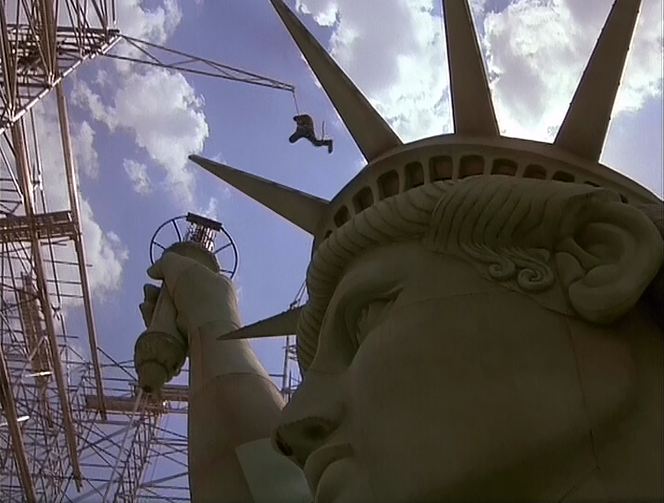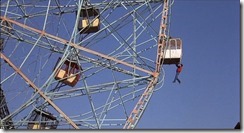SUCK WALL! REMO WILLIAMS: THE ADVENTURE BEGINS
REMO WILLIAMS: THE ADVENTURE BEGINS

Pros: Stuntwork is pretty astounding; nice use of real locations
Cons: Ending seems flat; potential problems with the Chiun character
Made in 1985 as the first installment of a series based on The Destroyer novels by Warren Murphy and Richard Sapir, Remo Williams: The Adventure Begins has to be one of best, consistently overlooked mindless action films from the ‘80s. The plot here centers around a former NYC policeman named Sam Makin who is recruited by a secret organization known as CURE who, after faking Makin’s death, rechristen him as the titular character (named after – you ready for this – a company who manufactures bedpans). CURE’s goal is to stamp out government corruption and this mainly involves taking down a manufacturer that is wasting government funds on weapons systems that are at best defective and quite possibly completely inoperable. Before that operation can proceed however, Williams must learn his craft from a “Korean master” named Chiun, thereby providing the film’s mandatory and nearly feature-long training sequence.

Remo and Chiun: not quite Mr. Miyagi and Daniel-san.
Christopher Wood’s script presents a mixture of the typically outrageous ‘80s action film story with a comic book mentality and plenty of goofball humor. The majority of the film deals with the interaction between Williams and Chiun: as might be expected, Chiun initially believes that training the very rough-around-the-edges Williams is a hopeless proposition and obviously, a major point of the script is to show that anything can be attained through hard work and perseverance. While the training sequence provides moments of dry wit and Three Stooges physical comedy, the familiar routine is a bit dull and nothing if not entirely predictable. Thankfully, Wood peppers the film with a handful of downright awe-inspiring action sequences that effectively break up the monotony and provide definitive highlight moments.

The crazy thing is, it seems like this was actually filmed at height on the huge scaffolding surrounding the Statue of Liberty. Note the Manhattan skyline in the background.
One such sequence finds Williams climbing on and through Coney Island’s famous Ferris Wheel, dodging incoming baskets and support wires as a way to test his mettle and overcome his fear of heights. Filmed in a way which really emphasizes the mind-blowing stunt work that had to be pulled off to complete the scene, even this impressive moment pales in comparison to another action set piece in which Williams encounters a gang of thugs on Liberty Island. In real-life 1985, a massive renovation project on the Statue of Liberty was ongoing, so the structure was surrounded by a tall scaffold. Needless to say, the film’s pursuit sequence that takes place in this criss-crossing maze of metal is nerve-wracking and exciting. Perhaps the most surprising thing about this film is that, unlike any number of Schwarzenegger or Chuck Norris vehicles from the period, Remo Williams doesn’t rely on over-the-top violence or plentiful explosions to keep a viewer interested. Director Guy Hamilton (who cut his teeth directing four Bond films from the ‘60s and ‘70s) simply emphasizes the impending peril that the main character is facing. His very assured handling of the material seems very old school (particularly compared to the loud and overblown action cinema of the post-Michael Bay era) yet is entirely effective: I certainly wish more of today’s directors would subscribe to his methodology in making this kind of film.

Stuntwork in the film is pretty outstanding – as is the replica Lady Liberty set.
Though he’s not quite the person I might have expected to play a role like this, Fred Ward (of Tremors fame) is actually very believable in the lead. It’s immediately apparent that the actor does many of his own stunts, which adds significantly to the viewing experience: I actually could buy Ward as a bad ass who could pull off these acrobatic parkour moves while ripping off one-liners at every opportunity. The script doesn’t allow for much genuine character development, but being entirely realistic or indeed logical isn’t remotely the point of this picture in the first place: it’s more or less a comic-book come to life. Playing Chiun we have obviously Caucasian actor Joel Grey. Depending on one’s perspective, Grey’s portrayal could either be taken as being quite humorous or completely offensive – the Chiun character is extremely stereotypical across the board, but listening to a painfully white dude deliver his interpretation of an “Asian accent” may be the icing on the cake. In 1985, being politically correct wasn’t much of an issue (particularly when dealing with Asians – I’m not so sure a character named – or like – “Long Duk Dong” would fly in 2015), and I guess today’s viewers can either choose to chuckle at the absurdity of the whole thing or find something else to watch. Regardless, there’s a nice rapport between Ward and Grey, especially when the two start exchanging wise cracks with one another. Ultimately, the chemistry between this duo benefits the picture since the story mostly revolves around them.

Grey and Ward have a nice rapport with one another – this picture sums up their interaction during the early parts of the film.
Smaller roles here are occupied by the likes of A. Wilford Brimley (under-utilized as the mastermind of CURE who spends the entire film pecking on a very primitive computer), J.A. Preston (as the streetwise CURE agent who is Williams’s only partner), Kate Mulgrew (an Army major investigating the corruption claims), and Charles Cioffi as a shady businessman who’s the main villain of the piece. I found it refreshing that a romantic relationship between Mulgrew and Ward’s characters never quite materialized even if the film’s somewhat goofy climax left the door open for one. Andrew Laszlo’s photography is outstanding with Craig Safan’s soundtrack adding punctuation to the more attention-grabbing moments, and the film makes exquisite use of authentic NYC locations. I was completely astonished by the fact that downtown Manhattan is visible in the background of many shots – particularly those filmed on the scaffold surrounding Lady Liberty. Amazing that some of these scenes could be pulled off and again, I really commend the stunt personnel who worked on this film.

Needless to say, Remo Williams didn’t find its audience at the box office, and the planned sequels and TV show never materialized. This is somewhat of a shame considering how decent this first film is – much better than any of the various, completely asinine flicks of the era starring the likes of Ah-nold Schwarzenegger (Commando or Raw Deal in particular), Chuck Norris, or Michael Dudikoff. Maybe Remo Williams: The Adventure Begins didn’t pack enough pyrotechnics or bullet-riddled bodies into its run time (the title character leaves many of his “victims” alive and the ending is admittedly flat), but whatever the case is, this genuinely fun movie is well worth rediscovering some three decades after its release. This is what the ‘80s were all about, and while this may not be a masterpiece of cinema, it’s indisputably entertaining.

MGM’s DVD version is, unfortunately and rather inexplicably, in full screen version only with no accompanying bonus features.
3/10 : Some violence and chopsocky; just a bit of blood
3/10 : Occasional minor profanity
1/10 : Fleeting sexual references, but not even a bit of romance – which is a actually a good thing
6/10 : Though imperfect, this is a definite step above the usual moronic ’80s action vehicle
“If I’m the best you could find, you’re in pretty deep shit, pal.”















